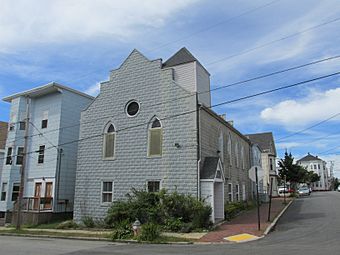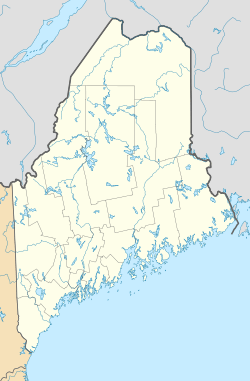Green Memorial A.M.E. Zion Church facts for kids
Quick facts for kids |
|
|
Green Memorial A.M.E. Zion Church
|
|

Green Memorial A.M.E. Zion Church
|
|
| Location | 46 Sheridan St., Portland, Maine, U.S. |
|---|---|
| Area | less than one acre |
| Built | 1914 |
| NRHP reference No. | 73000115 |
| Added to NRHP | January 17, 1973 |
The Green Memorial A.M.E. Zion Church is a special historic church located at 46 Sheridan Street in Portland, Maine, United States. It's a two-and-a-half-story building made of textured concrete blocks. It was built in 1914 for a church group that started in 1891.
The church is named after its founder, Moses Samuel Green. He was the richest African American in Portland at that time. In the middle of the 1900s, this church was a very important place for Portland's African American community. It hosted fun social events and was a center for organizing efforts to gain civil rights in Maine and across the United States.
The church's choir has performed all over Maine. The building was added to the National Register of Historic Places in 1973. This means it's recognized as an important historical site. Later, it was named one of three historic places in Maine directly connected to African American history. Reverend Kenneth I. Lewis has been the minister since 2003. In 2015, the church had 335 members from many different backgrounds.
Contents
What the Church Looks Like
The Green Memorial A.M.E. Zion Church is in Portland's eastern Munjoy Hill neighborhood. It's on the corner of Sheridan and Monument streets. It's a two-and-a-half-story building made of concrete blocks. The outside has a rough, textured finish.
The corners of the building have smooth blocks that stand out. The windows on the first floor are rectangular. The second floor has tall, pointed lancet windows made of colorful stained glass. The main entrance is near the street corner. It has a wooden porch with an open gable roof to protect it. A short wooden tower rises from the roof above the entrance.
Church History
How the Church Started
Moses Samuel Green was born into slavery in 1852. He moved from Maryland to Portland in 1888. He started a shoeshine stand and also bought and sold land. He became the wealthiest African American person in Portland. Some historians even think he might have been the wealthiest African American in all of Maine.
In 1891, Moses Green worked with other African Americans in Portland to start the A.M.E. Zion Mission. This mission used space in the Mount Zion A.M.E. Church. That church had been around since 1850 under different names. In 1907, Green and the church leaders bought the land at 46 Sheridan Street. The A.M.E. Zion Church was built there in 1914.
A house for the minister, called a parsonage, was finished next to the church in 1924. It was later turned into an office when a new parsonage was bought in 1973. Moses Green passed away in 1942. The next year, the church was renamed in his honor.
The Congregational Abyssinian Meeting House closed in 1917. Many of its members then joined the A.M.E. Zion church. Money and property from the Abyssinian Meeting House were given to Green Memorial in 1947. Because of this, Maine's State Historic Preservation Office mistakenly called Green Memorial the "descendent organization" of the Abyssinian Meeting House when it was nominated for the National Register of Historic Places in 1972.
The Mid-1900s: A Community Hub
When Green Memorial was built, most of Portland's African American population lived either west of downtown or east of downtown, near the church. By the middle of the 1900s, the church was involved in almost every activity happening in the Black community.
The church had a bulletin board where people could find out about job openings from employers who hired African Americans. Some church activities were organized by the Mis-Ter-Ray Club. This club was started in 1923 by women to plan tea parties, dances, and other social events. Their main goal was to raise money for the church.
The church also brought famous African American musicians like Roland Hayes and Marian Anderson to perform in Portland. African Americans from all over Maine used to gather every year on Independence Day. A bus from Green Memorial provided rides from Portland for families who couldn't drive themselves.
The church started hosting monthly chicken dinners in 1921. Church members sold tickets to people in the Portland area to raise money. One organizer was known for selling many tickets to local employers and city officials, who would then give them to their employees. Many church members worked in homes, and these dinners were held on Thursdays. This was usually their day off.
Historian Charles L. Lumpkins wrote that the church "provided a strong base for civil rights activities in the area." The church held important meetings. Its minister, John Bruce, even traveled to the March on Washington for Jobs and Freedom. The church's ninth minister, Reverend Stephen Gill Spottswood, volunteered for the NAACP. He helped them try to convince Maine's senators to vote for the 1918 Dyer Anti-Lynching Bill, which aimed to stop violence and unfair treatment.
While he was president of the Washington, D.C., chapter in the 1940s, Spottswood led efforts to end segregation in that city's schools and public places. He became the national chair of the NAACP by 1961. He reconnected with Green Memorial as a leader for the A.M.E.Z. New England Conference between 1964 and 1972.
From the Late 1900s to Today
The church was added to the National Register of Historic Places in 1973. By 1994, it was one of only three places in Maine on the National Register directly related to African American history. That year, after writing a newspaper series about Portland's African American history, journalist Shoshana Hoose worked with Karine Odine to create a documentary film called Anchor of the Soul. The word "anchor" in the title refers to how the church helped keep Portland's African American community strong in the 1900s.
Reverend Margaret Lawson became the church's minister in 1993. She was a gospel singer and led choir groups for community events during her time there. In 2000, Edward Wilmot Blyden's great-grandson, Eluem Blyden from West Africa, led the building of a traditional African canoe on the church property. This event happened at the same time as a sailing event in nearby Casco Bay. Lawson left the church in 2003. She was its longest-serving minister.
Reverend Kenneth I. Lewis became the minister in 2003. He has also taken on many important roles in the community. He became the director of the MaineHealth Center for Tobacco Independence. He is a member of the City of Portland Police Citizens Review Subcommittee. He also serves on the Portland Community Development Block Grant Allocation Committee. He is the Diversity Cabinet Chair and a board member of the United Way of Greater Portland.
In 2020, Governor Janet Mills appointed Lewis to a statewide group called the Permanent Commission on the Status of Racial, Indigenous and Maine Tribal Populations. He represents faith-based communities on this commission. The group's job is to find ways to solve problems related to racial differences in Maine.
In 2015, Green Memorial's church group had 335 members. About 60 percent of them were African American. In 2018, Reverend Lewis talked about how the church group is now made up of people from many different backgrounds. He said, "For years the statement was made that Sunday is the most segregated day in the United States. But not at the corner of Monument and Sheridan."
The Church Choir
The church is well-known for its choir. In 1998, the Green Memorial choir and the Williams Temple Church of God in Christ choir formed the Maine Gospel Choir. They performed The Movement, Revisited at Bates College. This was a musical about the civil rights movement of the 1960s.
In 2015, the choir performed at a special memorial service. This service was held at Merrill Auditorium for those who were killed in the Charleston church shooting. Reverend Lewis organized the memorial. More than 1,300 people attended.
See also



